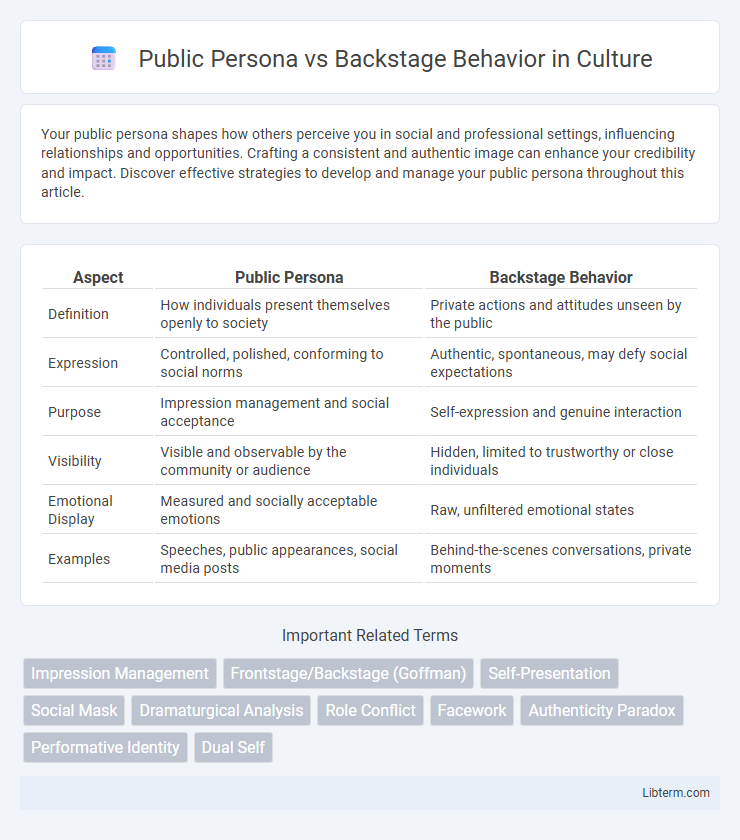Your public persona shapes how others perceive you in social and professional settings, influencing relationships and opportunities. Crafting a consistent and authentic image can enhance your credibility and impact. Discover effective strategies to develop and manage your public persona throughout this article.
Table of Comparison
| Aspect | Public Persona | Backstage Behavior |
|---|---|---|
| Definition | How individuals present themselves openly to society | Private actions and attitudes unseen by the public |
| Expression | Controlled, polished, conforming to social norms | Authentic, spontaneous, may defy social expectations |
| Purpose | Impression management and social acceptance | Self-expression and genuine interaction |
| Visibility | Visible and observable by the community or audience | Hidden, limited to trustworthy or close individuals |
| Emotional Display | Measured and socially acceptable emotions | Raw, unfiltered emotional states |
| Examples | Speeches, public appearances, social media posts | Behind-the-scenes conversations, private moments |
Defining Public Persona and Backstage Behavior
Public persona represents the curated image or identity an individual presents in social or professional settings, often designed to align with societal expectations or personal branding goals. Backstage behavior refers to the authentic, unfiltered actions and expressions displayed when individuals are away from the public eye, revealing true emotions, thoughts, and characteristics. Understanding the distinction between public persona and backstage behavior is essential for analyzing social interactions and psychological authenticity.
The Psychology Behind Dual Identities
The psychology behind dual identities reveals the intricate balance individuals maintain between their public persona and backstage behavior, shaped by social expectations and personal authenticity. Goffman's dramaturgical theory emphasizes how people perform roles in front of an audience, managing impressions to fit societal norms while reserving genuine self-expressions for private settings. This duality highlights cognitive dissonance and identity compartmentalization, as individuals navigate complex social environments to protect self-esteem and mental well-being.
Social Media’s Role in Shaping Public Image
Social media platforms amplify the divide between public persona and backstage behavior by allowing users to curate idealized versions of themselves. Algorithms prioritize engagement, often rewarding content that reinforces positive or sensational public images, which can distort authentic self-presentation. This dynamic shapes public perception and influences individual identity construction in digital spaces.
Cultural Expectations and Public Facades
Cultural expectations significantly shape the public persona individuals present, often leading to carefully constructed public facades that conform to societal norms. These facades serve as mechanisms to maintain social harmony and avoid conflict, reflecting the collective values and roles prescribed by culture. Backstage behavior, by contrast, reveals authentic attitudes and emotions that may contradict public performance, highlighting the tension between individual identity and communal expectations.
Consequences of Maintaining Multiple Personas
Maintaining multiple personas often leads to psychological stress, identity confusion, and decreased emotional well-being due to the constant effort required to align public behavior with private feelings. This dissonance can impair interpersonal relationships and reduce overall authenticity, as individuals struggle to reconcile conflicting self-presentations. Over time, the cumulative strain may result in burnout, anxiety, and diminished self-esteem, highlighting the significant consequences of managing divergent social roles.
Backstage Behavior: What Happens Out of the Spotlight?
Backstage behavior reveals individuals' authentic actions and interactions away from public scrutiny, highlighting genuine emotions and less structured conduct. This private sphere allows people to relax social norms and expectations, often exposing true motivations, insecurities, and relational dynamics. Understanding backstage behavior provides critical insights into identity formation and the contrast between public image and private reality.
Case Studies: Famous Figures and Their Contrasts
Analyzing case studies of famous figures like Marilyn Monroe and Steve Jobs reveals stark contrasts between their public personas and backstage behavior, highlighting the complexity of celebrity identities. Monroe's glamorous public image masked her private struggles with insecurity and mental health, while Jobs's charismatic visionary front often concealed a demanding and sometimes abrasive personality behind closed doors. These contrasts underscore the significance of understanding the duality in public figures for a nuanced perception of fame and character.
The Impact on Mental Health and Authenticity
Public persona and backstage behavior often diverge, creating tension that can impact mental health and authenticity. Maintaining a polished public image while hiding true feelings leads to stress, anxiety, and emotional exhaustion, undermining psychological well-being. Embracing authentic behavior in private settings supports mental resilience and fosters a genuine sense of self.
Navigating Public vs Private in the Digital Age
Navigating public persona versus backstage behavior in the digital age requires a strategic balance between curated online presence and authentic private interactions. Social media platforms blur boundaries, making it essential to manage personal information while maintaining credibility and trust in professional environments. Digital privacy tools and conscious content sharing empower individuals to control visibility and protect their backstage behavior from unintended public exposure.
Strategies for Achieving Authenticity
Achieving authenticity involves aligning public persona with backstage behavior through transparent communication and consistent actions that reflect true values. Employing self-awareness techniques aids in identifying discrepancies between outward image and internal beliefs, fostering genuine connections with others. Regular reflection and feedback integration ensure ongoing authenticity in both professional and personal interactions.
Public Persona Infographic

 libterm.com
libterm.com